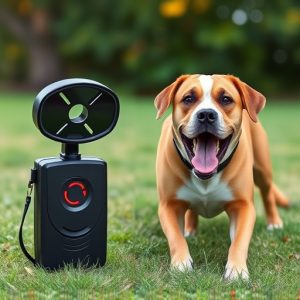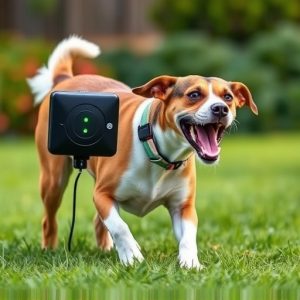Stationary vs Mobile Dog Repellents: Features & Best Choice Guide
This text provides a comprehensive comparison between stationary and mobile dog repellents, highligh…….
This text provides a comprehensive comparison between stationary and mobile dog repellents, highlighting their operational principles, applications, and advantages in various scenarios. Stationary options, fixed in place, use ultrasonic signals or scents to deter dogs over confined areas like gardens, while mobile repellents offer versatility by being moveable for greater control over different locations. The choice depends on space size, desired coverage, adaptability to conditions, and specific needs—whether long-term protection is required or a flexible, temporary solution.
“Exploring Effective Animal Repulsion: Unlocking the Power of Electronic Devices
In the realm of pet care, maintaining a harmonious coexistence with unwanted visitors is essential. This is where electronic animal repellents step in as modern solutions. Our comprehensive guide delves into the world of these innovative devices, focusing on stationary and mobile options. We present a detailed Stationary Vs Mobile Dog Repellent Comparison, exploring their unique features, advantages, and applications. By understanding how they work, you’ll make an informed choice to keep your space free from four-legged intruders.”
- Understanding Electronic Animal Repellents: How They Work
- Stationary Dog Repellents: Pros and Cons
- Mobile Dog Repellents: Advantages and Applications
- Comparative Analysis: Key Features to Consider
- Making an Informed Choice: Which Repellent is Right for You?
Understanding Electronic Animal Repellents: How They Work
Electronic animal repellents are innovative devices designed to deter unwanted animals from specific areas, offering a humane and environmentally friendly alternative to traditional repellents. These repellents work by emitting ultrasonic sounds or vibrations that are typically inaudible to humans but can be irritating to animals, encouraging them to stay away. Unlike spray or noise-based repellents, electronic versions remain stationary or portable, making them versatile for various settings.
When comparing stationary and mobile dog repellents, understanding their operational differences is key. Stationary repellents are typically installed in specific locations and emit consistent signals, effective for confined areas like gardens or patios. In contrast, mobile repellents offer flexibility, allowing users to move them between locations or even carry them outdoors during walks, ideal for addressing dog behavior issues in various environments.
Stationary Dog Repellents: Pros and Cons
Stationary dog repellents are designed to remain in one place, typically mounted on walls or fences, and emit ultrasonic sounds or scents that are unpleasant to dogs. They are ideal for use in gardens or outdoor spaces where a consistent presence is desired to keep dogs away. One of the main advantages is their convenience; once installed, they require minimal maintenance and can effectively deter dogs without any physical contact, making them safe for both pets and people. However, these devices have limited mobility, meaning they might not cover large areas effectively, and their effectiveness can be reduced by factors like weather conditions or obstructions that block the signal.
In contrast, mobile dog repellents offer a more versatile approach. These portable devices can be carried or moved to different locations as needed, allowing for greater control over the area being protected. They are excellent for temporary solutions or areas with frequent changes in dog activity patterns. However, regular movement is required to maintain their effectiveness, and they may not be as discreet as stationary options since they often need to be handled or transported. When considering a stationary vs mobile dog repellent comparison, the choice depends on factors like space size, desired coverage area, and the flexibility needed to adapt to changing circumstances.
Mobile Dog Repellents: Advantages and Applications
Mobile dog repellents offer a flexible and efficient solution for managing canine behavior in various settings. Unlike stationary repellents, they are portable and can be easily moved to different locations, making them ideal for outdoor activities, parks, campgrounds, and even urban environments. This mobility allows for dynamic control over dog movements, addressing issues like aggressive behavior, territorial marking, or simply keeping dogs away from specific areas.
In a comparison between stationary and mobile dog repellents, the latter provides an advantage in terms of versatility. Mobile devices can be strategically placed based on real-time needs, responding swiftly to changing behaviors. They are particularly useful for temporary events or situations where a fixed repellent might not be feasible. For instance, during training sessions or when introducing a new pet to a neighborhood, mobile repellents enable precise control and adjustment of the area affected, ensuring a more effective and targeted approach.
Comparative Analysis: Key Features to Consider
When comparing stationary and mobile dog repellents, several key features come into play, influencing your choice based on specific needs. Stationary repellents, as the name suggests, are fixed in one place, often powered by electricity or batteries, and designed to protect a particular area. They are ideal for enclosed spaces like patios, gardens, or farms, where consistent protection is needed without requiring constant movement. These devices usually offer broad-spectrum protection against various pests, including dogs, cats, and other wildlife, using ultrasonic waves or scent repellents.
In contrast, mobile dog repellents provide flexibility by allowing users to move them from one location to another. They are perfect for outdoor activities like camping, hiking, or protecting pets during backyard playtime. These repellents often utilize natural ingredients or high-frequency sounds to deter animals without causing harm. A key difference lies in their portability; mobile options can easily be carried and deployed anywhere, making them a convenient choice for on-the-go situations. Additionally, some models offer adjustable settings, allowing users to customize the intensity of the repellent based on different environments and animal behaviors.
Making an Informed Choice: Which Repellent is Right for You?
When choosing an electronic animal repellent, understanding the difference between stationary and mobile options is key. Stationary repellents are ideal for long-term use in fixed locations like gardens or farms. They emit a continuous signal that deters animals through sound, vibration, or ultrasonic waves, often with adjustable sensitivity settings to avoid false triggers.
Mobile dog repellents, on the other hand, offer versatility for those on the move. These devices are perfect for temporary outdoor activities like camping or hiking. They can be easily carried and deployed, using similar technology but in a more portable form factor. Consider your specific needs: whether you require a consistent, long-term solution or a flexible, temporary measure, to make an informed choice between stationary and mobile dog repellents.
In the ongoing quest to keep our spaces pest-free, both stationary and mobile dog repellents offer unique solutions. Understanding their pros, cons, and key features through a comprehensive comparison is crucial for making an informed choice. For those seeking permanent solutions in specific areas, stationary dog repellents provide consistent protection. On the other hand, mobile repellents are ideal for flexibility, with applications ranging from outdoor adventures to urban settings. Ultimately, the best option depends on individual needs and preferences, ensuring a peaceful coexistence between humans and their furry companions. When it comes to the Stationary Vs Mobile Dog Repellent Comparison, evaluating your specific requirements will help you select the most effective and suitable repellent.


